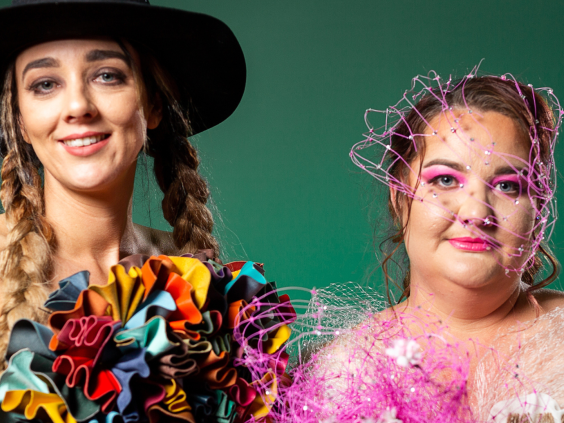Thought leadership: 20 June 2023
By Nina O’Brien, Disaster Resilience and Recovery Lead

In 2022, as multiple disaster events were occurring nationally, there was a collective focus on recovery and preparedness practices.
Curious to better understand how to strengthen support for communities, particularly at a local level, the Creative Recovery Network (CRN) and the Foundation for Rural & Regional Renewal (FRRR) partnered to investigate the valuable role that creative projects, initiatives, collaborations and processes play when communities are recovering from disaster or other significant climate impacts. This had led to the Impacts of Creative Recovery report.
With a shared focus on strengthening social capital, both CRN and FRRR have long understood the importance of creative-led recovery practices. The Creative Recovery Network is the lead agency building recovery capability by linking the creative sector with communities and disaster management to grow and connect through the disaster experience. FRRR is the only national foundation specifically focused on ensuring the social and economic strength of remote, rural and regional communities.
While recovery practices are typically varied and nuanced, creative recovery is a particular approach to supporting both individuals and communities after a disaster event. It involves using creative activities as tools for communities to reduce emotional impacts, build resilience, foster connection, and support wellbeing.
Purpose and approach to the study
The research commissioned by FRRR and CRN was designed to document the broader benefits of creative-led recovery and explore whether creative recovery provides valuable, cost-effective and approaches to support individual and community wellbeing within a disaster response. We also wanted to understand if, and how, it contributes to enhanced recovery outcomes and community resilience over the longer-term. A further aim, assuming the research did indeed confirm other anecdotal and lived experience, was to strengthen support for appropriate resourcing, activation and embedding of these practices in processes and planning.
The study reviewed and analysed five community recovery projects that were funded by FRRR. These projects involved diverse creative recovery approaches and were undertaken in very different locations and disaster environments across Australia between 2015 and 2020. Looking back at these historic projects allowed analysis of the long-term outcomes and impacts of this range of work.
There were four broad themes through which the impact of creative recovery was explored:
- Social Capital and Connection;
- Revitalisation and Placemaking;
- Acceptance and Growth; and
- Identity and Belonging.
Findings confirm lasting impacts of creative recovery projects
Collaborative and community led creative recovery activities and projects build on existing local strengths, networks and resources, and can help to lessen impacts and the sense of isolation and disempowerment resulting from disaster events. Significantly, where creative recovery projects are inclusive and participatory by design they leave a lasting legacy, which has far reaching benefits for communities.
Additionally, the retrospective review showed creative recovery projects also built knowledge and understanding of mental health, wellbeing practices and resources. By collaborating and contributing to these creative recovery projects at a local level, community members built positive experiences and perspectives. Projects studied had a significant impact on individuals’ sense of self-worth and confidence, while also enhancing the sense of place and establishing lasting connections to place, culture and traditions.
So, the study has done what we hoped it would: highlight that creative recovery has the unique ability to build long-lasting community resilience, wellbeing and enhanced local capacity for disaster preparedness, response and recovery.

Key ingredients for leaving a lasting legacy
The study identified a number of common factors in projects that had a lasting impact and legacy in their communities. This included:
- Program design being based on community-led processes
- Building upon local strengths, networks and resources
- Planning and delivery are expertly coordinated
- The project was inclusive, participatory and collaborative
- Ensuring the initiative provides mentorship and education opportunities;
- Leaving a lasting, tangible cultural output;
- Having ongoing funding support; and, critically
- Being led by passionate, dedicated and well-connected local leaders.
Similarly it identified some common challenges, including funding and the retention of either paid staff, expert facilitators and volunteers, especially for large-scale projects.
New approaches recommended
This report adds weight to the growing evidence of the value of embedding creative recovery approaches in future disaster management planning and processes.
Drawing on clear evidence in each project across each of the evaluation dimensions, the report recommends:
- Funding bodies provide ongoing financial support for creative recovery programs;
- Government and disaster management agencies embed Creative Recovery processes in to policy that is integrated into wider disaster management arrangements; and
- Local communities value and invest in their creative economy to provide ongoing participation and employment in the arts.
As we turn our attention to improving disaster preparedness, response and recovery efforts, this report illuminates ways that creative recovery approaches to disaster management can provide opportunities to foster community collaboration and more specifically enhance individual and community resilience and wellbeing.
We encourage all those working in this space to explore the report.

